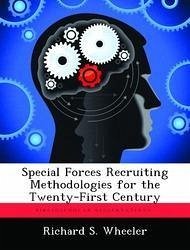This research examines the Special Forces recruiting methodologies for the twenty-first century. The analysis highlights the origins of the U.S. Army Special Forces from 1952 to the establishment of the Special Forces as a separate combat arms branch of the Army on 9 April 1987. An overview of the force development process conducted at echelons above the United States Army Recruiting Command was presented in order to appreciate the process of setting and adjusting the Special Forces recruiting mission. In greater detail, historical trends, as documented from secondary research, provides the framework of the analysis by examining what occurred in the past in order to preview the relevant effectiveness of recruiting methodologies in practice today. The analysis articulates the importance of mutually supporting relationships, established as early as 1990 and continue to prosper today, between numerous civilian and military agencies involved in the accession of the future Special Forces force structure. The complex realities of recruiting Special Forces, to include the market, internal and external influences that impact the ability to succeed in the conduct of the phenomenon, are addressed as well. Having researched the phenomenon of recruiting and presented the facts and findings that resulted from critical analysis, the recommendations and conclusions are based on secondary and primary research, study, analysis, and logical presentation of the data in order to serve as the vehicle for future research of the phenomenon.








